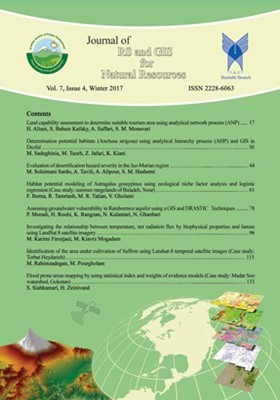-
-
List of Articles
-
Open Access Article
1 - Land capability assessment to determine suitable tourism area using analytical network process (ANP)
Hamideh Aliani Sasan Babaie Kafaky Amir Saffari seyed Masoud Monavari -
Open Access Article
2 - Determination potential habitats (Anchusa strigosa) using analytical hierarchy process (AHP) and GIS in Dezful
Majid Sadeghinia Mehdi Tazeh Zahra Jafari Koroush Kiani -
Open Access Article
3 - Evaluation of desertification hazard severity in the Jaz-Murian region
Mojtaba Soleimani Sardo Ali Tavili Abbas Alipour Seyed Mostafa Hashemi -
Open Access Article
4 - Habitat potential modeling of Astragalus gossypinus using ecological niche factor analysis and logistic regression (Case study: summer rangelands of Baladeh, Nour)
Farhad Borna Reza Tamartash Mohammadreza Tatian Vahid Gholami -
Open Access Article
5 - Assessing groundwater vulnerability in Ramhormoz aquifer using a GIS and DRASTIC Techniques
Pouriya Moradi Hassan Rouhi Kazem Rangzan Nasrollah Kalantari Nazanin Ghanbari -
Open Access Article
6 - Investigating the relationship between temperature, net radiation flux by biophysical properties and lanuse using LandSat 8 satellite imagery
Mohammad Karimi Firozjaei Majid Kiavrz Mogadam -
Open Access Article
7 - Identification of the area under cultivation of Saffron using Landsat-8 temporal satellite images (Case study: Torbat Heydarieh)
Majid Rahimzadegan Mostafa Pourgholam -
Open Access Article
8 - Flood prone areas mapping by using statistical index and weights of evidence models (Case study: Madar Soo watershed, Golestan)
Safoura Siahkamari Hossein Zeinivand
-
The rights to this website are owned by the Raimag Press Management System.
Copyright © 2021-2025







